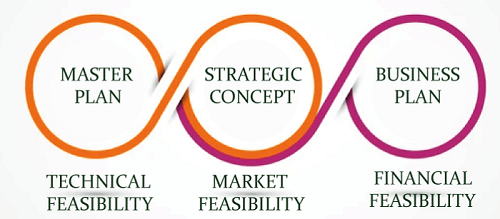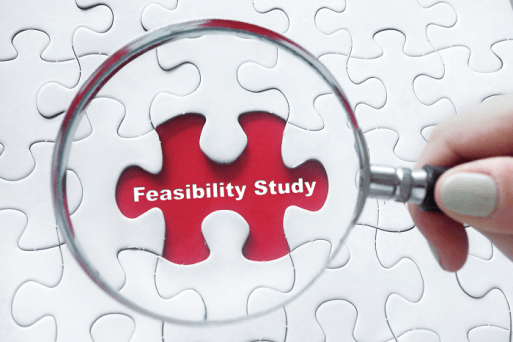Feasible StudyA feasibility study analyzes the viability of a proposed project or venture. It is used to evaluate a project's potential, including the technical, financial, and economic aspects, and to determine whether it should proceed. A feasibility study aims to identify and assess a proposed project's strengths, weaknesses, opportunities, and threats to determine its potential for success. 
Feasibility Study ProcessThe feasibility study process typically includes a variety of tasks, such as market research, technical analysis, financial analysis, and risk assessment. Market research is used to identify the demand for the proposed product or service and the competition and potential customers. Technical analysis is used to evaluate the technical aspects of the project, such as the design and production methods, and to determine whether the project is technically feasible. Financial analysis is used to evaluate the project's financial viability, including the costs and revenues, and to determine whether the project is financially feasible. Risk assessment is used to identify and evaluate the project's potential risks, such as regulatory, market, and financial risks, and to determine the project's overall risk profile. The outcome of a feasibility study is a report that summarizes the study's findings and provides recommendations for proceeding with the project. If the study finds the project feasible, the report will recommend proceeding with the project and may include a detailed project plan and budget. If the study finds that the project is not feasible, the report will recommend not proceeding with the project and may include suggestions for alternative projects. It's important to note that feasibility studies are not always required for all projects, but they are particularly useful for larger, more complex projects that require significant investment. A simple cost-benefit analysis may be sufficient for smaller or less complex projects. Additionally, feasibility studies are often used to secure funding from investors, banks, or other sources, as they provide a detailed analysis of the project's potential for success. In short, a feasibility study is a tool that helps to evaluate the potential of a proposed project or venture by analyzing the technical, financial, and economic aspects. 
Domains of Feasible StudyFeasibility studies typically cover several domains, including market, technical, financial, and organizational. Each domain provides information and analysis that helps to evaluate the potential of the proposed project or venture. The market domain assesses the demand for the proposed product or service, competition, and potential customers. This includes research on the market size, growth, trends, and segmentation, as well as analyzing the target market and their needs, preferences and buying habits. The market research also includes a competitive analysis, which provides information on the competitors, their market share, strengths and weaknesses, and how the proposed project or venture will compare and compete in the market. The technical domain evaluates the technical aspects of the project, such as the design and production methods, and determines whether the project is technically feasible. This includes a detailed engineering and design analysis and a review of the equipment, materials, and technology required for the project. It also includes an assessment of the project's scalability and adaptability and an analysis of the feasibility of any new or innovative technologies that may be required. The financial domain assesses the project's financial viability, including the costs and revenues, and determines whether the project is financially feasible. This includes a detailed financial analysis, such as a cost-benefit analysis, a break-even analysis, and a cash flow analysis. It also includes an assessment of the project's funding requirements, including the funding sources and the terms and conditions of any financing arrangements. The financial analysis also includes an assessment of the project's Return on Investment (ROI) and Net Present Value (NPV). The organizational domain assesses the project's feasibility, including the project's human resources, management, and administrative aspects. This includes an analysis of the project's organizational structure, roles, and responsibilities and an assessment of the project's management and administrative systems. Benefits of Feasibility
How to Conduct a Feasible StudyThe structure of a feasibility study will be determined by the type of organization that requires it. Regardless, comparable factors will be engaged, regardless of how their weighting alters. Even though each assignment has unique objectives and needs, there are a few standard techniques for conducting each feasibility study:

Recommended ComponentsThe real work begins once the reasonable underlying degree of effort has been completed. Parts of a feasibility study that are commonly encountered include the following:
Example of a Feasibility studyThe following are two examples of feasibility studies. The first involves college development plans. The second is a genuine model headed by the Washington State Department of Transportation and backed by Microsoft Inc. A Science Building at a CollegeAuthorities at a college were concerned that the science building, which had been in use since the 1970s, was antiquated. Taking into account the most recent 20 years of creative and logical advancements, they needed to explore the cost and benefits of revamping and expanding the structure. A feasibility study was conducted. In the preliminary investigation, school officials considered several options, weighing the benefits and costs of expanding and renovating the science building. Some school officials were concerned about the project, particularly the cost and potential community opposition. The new scientific building would be far larger, and the local area board had already rejected a related proposal. The feasibility study must address these concerns and potential legal or drafting issues. The feasibility study also looked at the mechanical needs of the new scientific office, the benefits to students, and the school's long-term suitability. An updated scientific office would broaden the school's logical investigation capacities, work on its teaching programme, and attract new students. Monetary forecasts demonstrated the cost and scope of the project, as well as how the school expected to obtain the necessary assets, which included appealing to financial backers and leveraging the institution's approval. The predictions also demonstrated how the expanded office would enable more understudies to enrol in science programmes, increasing money from educational costs and expenses. The feasibility analysis demonstrated that moving forward with the scientific building's refurbishment and expansion plans was reasonable. The school's administrators would never have been able to determine if their extension plans were feasible without conducting a feasibility assessment. A High-Speed Railway ProjectThe Washington State Division of Transportation decided to focus its feasibility study on constructing a high-speed rail connecting Portland, Oregon, Seattle, Washington, and Vancouver, British Columbia. The goal was to build a stable natural transportation system to increase the Pacific Northwest's importance and future prosperity. An administrative framework for future direction was shown in the initial inquiry. The evaluation involved talking to experts and partners to determine the optimal administrative system, assessing administrative designs, and learning from already completed fast rail projects in North America. As a result, managing and organizing components were developed to oversee and carry out the project, assuming the state assembly would approve it. An important commitment strategy includes an objective technique with the general public, selected authorities, government agencies, corporate visionaries, promotion events, and local networks. The commitment plan was designed to be flexible, considering the scope, size, and number of cities and towns that seemed to be involved. A group of leadership council members was established, and they gathered to discuss policies, provide examples from previous jobs, and consult with experts to create a system. The financial portion of the feasibility focus outlined the task's funding process, which also looked into obtaining assets from state, federal, and private ventures. The estimated cost of the enterprise ranged from $24 billion to $42 billion. It was estimated that the high-speed rail framework would generate between $160 million and $250 million in revenue. The study divided the financing and subsidizing sources of money. The term "funding" refers to government-issued securities, loans from financial institutions, and value speculations, which are advances against future revenue that must be repaid with interest. The term "subsidizing" was used to refer to grants, distributions from the local or state government, and revenue. As the task advanced, different areas would need different amounts of cash. The majority of the subsidizing would come from the public authority in the early stages, and as the initiative developed, money and promises from the private sector would take over. Microsoft Inc. was one of the project's secret donors, contributing more than $570,000. The benefits outlined in the achievability report indicate that the region will see improved interconnectivity, taking better population management and boosting regional monetary development by $355 billion into consideration. The improved transportation system would allow them access to better jobs and more affordable housing. The quick rail system also frees up areas where car traffic is backed up. The review's timeline began in 2016 when an agreement was made with English Columbia to work together on another innovation hall that would feature high-speed rail transit. The Washington State Land Council received the potential report in December 2020. What is the Main Objective of a Feasibility Study?Feasibility analysis is meant to help managers determine if a new business or speculative idea has a good chance of succeeding. It makes a distinction between general costs and typical benefits. "Fruitful" in business refers to a situation where the financial gain outweighs the cost. Achievement in a charity might be measured in several ways. The benefit of an enterprise to the community it serves could be worth the cost. What are the Steps in a Feasibility Study?A basic examination comes before a feasibility study. A marketable plan is ready when partners have been assessed, and statistical surveying has been conducted. The breakdown of this information enables a fundamental "go" or "off limits" decision to be made. The real examination may begin if everything is okay. This involves presenting the original ideas, focusing on the commercial area, displaying the advertising strategy, and highlighting the crucial human resources, project timeline, and financial requirements. 
ConclusionA feasibility study focuses on helping project managers assess an undertaking's justification by identifying factors contributing to its success. The focus also highlights potential speculative gains and risks to the project's success. A feasibility study includes a detailed analysis of the resources needed to complete the project as envisioned. A description of the new product or business, a market analysis, the innovation and effort necessary, as well as the sources of finance and resources, might all be included in the report. The report will also include financial predictions, the likelihood of progress, and, finally, a go-or-off-limits decision.
Next TopicForward Price to Earnings (Forward P/E)
|
 For Videos Join Our Youtube Channel: Join Now
For Videos Join Our Youtube Channel: Join Now
Feedback
- Send your Feedback to [email protected]
Help Others, Please Share









